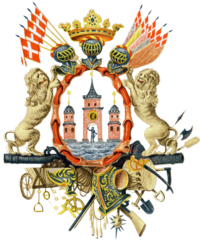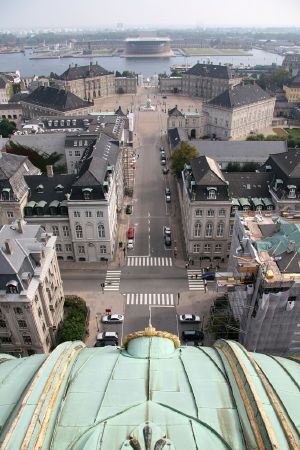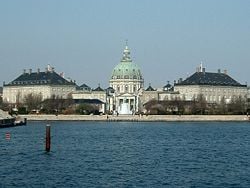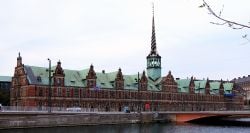Copenhagen

| |
| City coat of arms | |

| |

| |
| Area | |
|---|---|
| - Municipal | 88.25 km² |
| - Capital region | 2673 km² |
| Population (2008-01-01) | |
| - Municipal | 509,861 |
| - Urban area | 1,153,615 |
| - Metropolitan Area(Central Øresund Region) | 2,812,977 |
| - Density (city/met/region/region+) | 5777/1947/812/686/km² |
| Additional information | |
| Time zone | Central European: UTC+1 |
| Latitude Longitude |
55°43' N 12°34' E |
Copenhagen (IPA: /ˌkəʊpənˈheɪgən, ˌkəʊpənˈhɑːgən, ˈkəʊpənˌheɪgən, ˈkəʊpənˌhɑːgən/; IPA: [kʰøb̥ənˈhɑʊ̯ˀn, kʰøb̥m̩ˈhɑʊ̯ˀn]), the capital and largest city of Denmark, is located on the Zealand and Amager Islands, and is separated from Malmö, Sweden, by the strait of Øresund.
With the completion of the transnational Oresund Bridge in 2000, Copenhagen and Malmö are connected by a car/rail link and are in the process of integrating their labour markets, resulting in increasing numbers of commuters from both sides. These two cities together form the center of the Øresund Region, which is home to almost 3.7 million inhabitants.
In 2008, the magazine Monocle listed Copenhagen first in their Top 20 Most Livable Cities Chart[1], and gave the city the special award as "Best Design City". In addition, it has also been classified as a GaWC Cultural World City, while it is third in Western Europe in terms of attracting regional headquarters and distribution centers, only surpassed by London and Paris.[2]
Geography
The original name for the city, from which the contemporary Danish name is derived, was Køpmannæhafn, "merchants' harbor". The English name for the city is derived from its Low German name, Kopenhagen. The element hafnium is named after the city's Latin name, Hafnia[3].
Copenhagen is located on the eastern shore of the island of Zealand (Sjælland) and partly on the island of Amager. Copenhagen faces the Øresund to the east, the strait of water that separates Denmark from Sweden, and that connects the North Sea with the Baltic Sea. On the Swedish side of the sound directly across from Copenhagen, lie the towns of Malmö and Landskrona.
Copenhagen is also a part of the Øresund region, which consists of Zealand, Lolland-Falster and Bornholm in Denmark and Scania in Sweden.
The weather in Copenhagen is mild through all the four seasons. Summers bring temperatures averaging around 68°F (20°C), while in mid-winter temperatures hover just above or below zero. Rainfall is moderate too, but spread throughout the year, so showers are possible in any season. Mean annual precipitation is 23.1 inches (589mm). Grey skies are the norm rather than the exception in Copenhagen.
The Rådhuspladsen, or the “Town Hall Square”, is the old center of the city, from which an old shopping street leads northeast to Kongens Nytorv, or “King’s New Square”, which was laid out in the 17th century. Christiansborg Palace, which is built on the site of Bishop Absalon's old castle, is located on the island of Slotsholmen, or “Castle Islet”.
Suburban Copenhagen is planned according to Fingerplanen, "The Finger Plan", initiated in 1947, dividing the suburbs into five fingers. The S-train lines are built according to The Finger Plan, while green belts and highways are built in-between the fingers
The northern suburbs, forming the little finger of the plan, are the wealthiest, with mansions, larger houses, garden cities and mid-size houses. The north-northwestern suburbs form the ring finger, with detached middle-class dwellings. The northwestern suburbs form the middle finger, and consists of detached middle-class dwellings, widespread garden cities, large, low-rise public housing projects, and industrial areas.
The pointer finger are in the west, and have the lowest income per capita and the highest crime-rate. The southwest suburbs along the coast form the thumb, and include high-rise housing projects and low-income inhabitants.
Amager island was later included in the city's suburban plan. Copenhagen covered 1032 square miles (2923 square kilometers) in 2008.
History
Signs of human activity dating back to about 4000 B.C.E. have been found around Copenhagen, but there are no signs of permanent settlements from that time.[4]
Archaeological excavations indicate that the first town dates back to the 11th century and consisted of two settlements, one in the western part of the medieval city encircled by what is now the streets of Mikkel Bryggersgade, Vestergade, Gammeltorv/Nytorv and Løngangsstræde, which roughly corresponds to the coastline of the time,[5] and another smaller settlement at what is now Kongens Nytorv.[6][7] The surrounding area consisted of moist beach meadows and signs of cattle grazing have been found.[5] The city probably had a harbour located at present day Højbro Plads.[8]
From the Viking Age there was a fishing village by the name of "Havn" (harbour) at the site.
In 1167, Bishop Absalon of Roskilde, built a castle on an islet off the coast, and fortified the town. That year traditionally marks the foundation of Copenhagen. The excellent harbour encouraged Copenhagen's growth until it became an important centre of commerce (hence its name - the first part of the word denoting commerce in Danish language). It was repeatedly attacked by the Hanseatic League as the Germans took notice. In 1254, it received its charter as a city under Bishop Jakob Erlandsen.
In 1445, Copenhagen became the residence of the royal family and was made the capital of Denmark. Copenhagen’s trade began to flourish by the late 16th century. New buildings erected at that time included the Børsen (Exchange), the Holmens Church, Trinitatis Church, with the adjacent famous Round Tower, and the palace of Rosenborg.
During 1658-59, Copenhagen withstood a two-year siege by the Swedes under Charles X and successfully repelled a major assault.
Fires in 1728 and 1795 destroyed much of the city.
In 1801, a British fleet under Admiral Parker fought the Battle of Copenhagen, against the Danish Navy in Copenhagen harbour. It was during this battle Lord Nelson famously "put the telescope to the blind eye" in order not to see Admiral Parker's signal to cease fire.
When a British expeditionary force bombarded Copenhagen in 1807, to gain control of the Danish Navy, the city suffered great damage and hundreds of people were killed. The reason why the devastation was so great was that Copenhagen relied on an old defence-line rendered virtually useless by the increase in shooting range available to the British.
But not until the 1850s were the ramparts of the city opened to allow new housing to be built around the lakes ("Søerne") which bordered the old defence system to the west. This dramatic increase of space was long overdue, not only because the old ramparts were out of date as a defence system, but also because of bad sanitation in the old city. Before the opening, Copenhagen Center was inhabited by approximately 125,000 people, peaking in the census of 1870 (140,000); today the figure is around 25,000. In 1901, Copenhagen expanded further, incorporating communities with 40,000 people, and in the process making Frederiksberg an enclave within Copenhagen.
During World War II, Copenhagen was occupied by German troops along with the rest of the country from April 9, 1940, until May 4, 1945. In August 1943, when the government's collaboration with the occupation forces collapsed, several ships were sunk in Copenhagen Harbour by the Royal Danish Navy to prevent them being used by the Germans. The city has grown greatly since the war, in the seventies using the so-called five-finger-plan of commuter trainlines to surrounding towns and suburbs.
Since the summer 2000, the cities of Copenhagen and Malmö have been connected by a toll bridge/tunnel (Øresund Bridge), which allows both rail and road passengers to cross. As a result, Copenhagen has become the centre of a larger metropolitan area which spans both nations. The construction of the bridge has led to a large number of changes to the public transportation system and the extensive redevelopment of Amager, south of the main city.
Government
Denmark is a constitutional monarchy. The monarch, an inherited position, is chief of state. The prime minister, who is the leader of the majority party or coalition after legislative elections, is appointed by the monarch as head of government. The unicameral People's Assembly, or Folketinget, comprises 179 members elected by popular vote on the basis of proportional representation to serve four-year terms.
Copenhagen is the largest city in the administrative region of Hovedstaden, although Hillerød is the capital of that region. The most important responsibility for each of Denmark's five administrative region's is for health, along with employment and public transport.
The conurbation of Copenhagen consists of several municipalities, the largest of which is Copenhagen municipality, followed by Frederiksberg municipality an enclave inside Copenhagen municipality. Copenhagen municipality has 55 municipal councillors. Council elections are held on the third Tuesday of November every four years.
In 2008, the Lord Mayor of Copenhagen was Ritt Bjerregaard, a member of the Social Democrats political party, who was head of the finance committee. Other mayors were Pia Allerslev (cultural and recreational committee), Bo Asmus Kjeldgaard (education and youth committee), Mogens Lønborg (health and care committee), Jakob Hougaard (employment and integration committee), Klaus Bondam (building and environment committee), and Mikkel Warming (social committee). The municipal seat of government is the Copenhagen City Hall (Rådhus).
Economy
Denmark's thoroughly modern market economy features high-tech agriculture, up-to-date small-scale and corporate industry, extensive government welfare measures, comfortable living standards, a stable currency, and high dependence on foreign trade.
Copenhagen formerly was the location of most of Denmark’s manufacturing. From 2000, the service sector, trade, finance, and education dominated the city’s economy.
The Copenhagen Capital Region had both the highest GDP per capita and economic growth in the whole of Denmark in 2005.[9] In a 2006 survey of the richest cities in the world, Copenhagen was ranked 9th, and along with the Norwegian capital Oslo the highest gross wages were paid in Copenhagen, but the high taxes mean that wages are reduced after mandatory deduction.[10] Denmark's per capita GDP was estimated at $37,400 in 2007.
Furthermore, Copenhagen has in several surveys been ranked as one of the most expensive cities in the World.[11][12] In a newly released survey by the Swiss bank UBS AG, the second largest bank in Europe by market capitalisation, Copenhagen had the highest gross wages in the World[13], and the average wage earner in Copenhagen earned somewhat 40 percent more than the average person in New York, considering the 14 most prevalent crafts [14], but when considering the tax level and general prices, Copenhagen drops down to a 6th place in the survey and in a calculation of the hourly domestic puchasing power, with the most common average expenses and rent included, Copenhagen only reaches a 16th place, behind cities such as Zurich, Munich and Oslo.
Several international companies have established their regional headquarters in Copenhagen, e.g. Microsoft. Maersk, the world's largest container shipping company, has their world headquarters in Copenhagen. A substantial number of Danish pharmaceuticals such as Novo Nordisk, Ferring Pharmaceuticals and Bavarian Nordic also operate in the area, having placed their headquarters in or close to Copenhagen.[15]
Copenhagen is a transport hub for Northern Europe. The city has a large network of toll-free highways and public roads connecting different municipalities of the city together and to Northern Europe. Public transport consists of commuter trains (called "S-trains" (S-tog)), buses, and a metro.Bicycle paths are often separated from the main traffic lanes and sometimes have their own signal systems. Public bicycles can be found throughout the downtown area and used with a returnable deposit of 20 kroner.
The main function of the harbour of Copenhagen, since 2001 merged with Malmö to Copenhagen-Malmö Port, is a cruise destination. Copenhagen has two airports, Kastrup (the large international airport) and Roskilde Lufthavn (a smaller international and general aviation airport). Malmö Airport is situated about 55km from central Copenhagen, and is used by low-cost carriers and chartered airplanes.
Demographics
Depending on the boundaries used, the population of Copenhagen differs. Statistics Denmark uses a measure of the contiguously built-up urban area of Copenhagen, providing a figure of 1,153,615 inhabitants in 2008.
Statistics Denmark has worked out definitions of so-called lands (landsdele), a definition used to meet statistical needs on a lower level than regions. From this, the land of Copenhagen city (København by) is defined by the municipalities of Copenhagen, Dragør, Frederiksberg and Tårnby, with a total population of 656,582 in the beginning of 2008.[16][17] The surroundings of Copenhagen is defined by another land, Copenhagen suburban (Københavns omegn), which includes the municipalities of Albertslund, Ballerup, Brøndby, Gentofte, Gladsaxe, Glostrup, Herlev, Hvidovre, Høje-Taastrup, Ishøj, Lyngby-Taarbæk, Rødovre and Vallensbæk, and with a total population of 504,481 (January 1 2008).[16][17]
The region comprises 6.8 percent of the land area of Denmark, but has 33.9 percent of Denmark's population. This gives a total of 637 inhabitants per km² or 1650 per square mile for the region. This compares with a population density in the rest of the country of approximately 90 per km² or around 230 per square mile.
Most people are of Scandinavian descent, with small groups of Inuit (from Greenland), Faroese, and immigrants, who make up six percent of the population, and mostly come from neighboring northern European countries. An increase in numbers from southern Europe and the Middle Eastern countries has caused increasing tension as Danes feel their liberal society is under threat from a non-liberal Muslim Arab minority.
Danish is spoken in the entire country, although a small group near the German border also speaks German. Many Danes are fluent in English, which is the predominant second language.
According to 2006 statistics, 83 percent of Danes are members of the Lutheran state church, the Danish People's Church (Den Danske Folkekirke), also known as the Church of Denmark.
Evangelical Lutherans made up 95 percent of the population in 2008, other Christian (includes Protestant and Roman Catholic) 3 percent, and Muslims 2 percent, according to the World Fact Book 2008.
Copenhagen is home to the oldest and largest university in Denmark, the University of Copenhagen founded in 1479. Other tertiary institutes include the Technical University of Denmark, the Engineering Academy of Denmark, the Royal Danish Academy of Music, the Copenhagen School of Economics and Business Administration, and the Royal Veterinary and Agricultural College.
Of interest
- Amalienborg Palace is the winter home of the Danish royal family, and consists of four identical classicizing palace façades with rococo interiors around an octagonal courtyard. In the center of the square is a monumental equestrian statue of Amalienborg's founder, King Frederik V.
- Christiansborg Palace, in central Copenhagen, is the house of Denmark's three supreme powers: the executive power, the legislative power, and the judicial power. It is the only building in the world which is the home of all a nation's three supreme powers.
- Frederiksborg Palace was built as a royal residence for King Christian IV, and is now known as The Museum of National History. The current building replaced a previous castle erected by Frederick II, and is the largest Renaissance palace in Scandinavia.
- Strøget (literally "the straight" or to wander), a carfree zone, is a popular tourist attraction in the centre of town, and is the longest pedestrian shopping area in Europe.
- The statue of The Little Mermaid sits on a rock in the Copenhagen harbour at Langelinie. This small and unimposing statue is a Copenhagen icon and a major tourist attraction.
- The National Museum of Denmark, in Prinsens Palais, is Denmark's central museum of cultural history, comprising the histories of Danish and foreign cultures, alike.
- The Church of Our Lady is the National Cathedral of Denmark. Construction of the original Collegiate Church of St Mary began no later than 1187 under Bishop Absalon
The botanical gardens laid out in 1874 have an observatory with a statue of the Danish astronomer Tycho Brahe.
- Tivoli Gardens, which is a famous amusement park and pleasure garden. The park opened in 1843 and, except for Dyrehavsbakken in nearby Klampenborg, it is the oldest amusement park which has survived intact to the present day.
- The Ny Carlsberg Glyptotek, which is an art museum built around the personal collection of the son of the founder of the Carlsberg Breweries, Carl Jacobsen. The museum collections include classical Egyptian, Roman and Greek antiquities, Romanticist sculptures, and paintings, as well as Golden Age Danish art. The Etruscan collection is one of the most extensive outside Italy.
- Copenhagen Zoo, one of the oldest zoos in Europe, was founded by the ornithologist Niels Kjærbølling in 1859.
Music and entertainment
The Copenhagen Jazz Festival, which takes place in summer, is a popular annual event that is the result of a significant jazz scene having existed for many years. It developed when a number of American jazz musicians such as Ben Webster, Thad Jones, Richard Boone, Ernie Wilkins, Kenny Drew, Ed Thigpen, Bob Rockwell and others such as rock guitarist Link Wray came to live in Copenhagen during the 1960s.
Recently, the Hafnia Chamber Orchestra has been added to the cultural platform of Copenhagen. Established by the talented conductor Simon Casali-Krzentowski in 2001, the Hafnia Chamber Orchestra strives to bring Danish composers to a wider audience.
For free entertainment one can stroll along Strøget, especially between Nytorv and Højbro Plads, which in the late afternoon and evening is a bit like an impromptu three-ring circus with musicians, magicians, jugglers and other street performers.
Sports
Copenhagen has a wide variety of sport teams. The football team, FC København, are based in Copenhagen. FC København plays at Parken in Østerbro, Copenhagen. Notable Copenhagen teams playing at the second highest level in Danish football (the Danish 1st Division) include Lyngby BK, AB, HIK, Frem, Brønshøj, Fremad Amager and Skjold.
Copenhagen also has three ice hockey teams: Rødovre Mighty Bulls, Herlev Hornets and Nordsjælland Cobras.
There are a lot of handball teams in Copenhagen. FC København owns both a women's and a men's team, which have the same name and logo. They were formerly known as FIF. Of other clubs playing in the "highest" leagues there are; Ajax Heroes, Ydun, and HIK (Hellerup).
Rugby union is also played in the Danish capital with teams such as CSR-Nanok, Copenhagen Scrum, Exiles, Froggies and Rugbyklubben Speed.
The Danish Australian Football League, based in Copenhagen is the largest Australian rules football competition outside of the English speaking world.
Copenhagen is also home to a number of Denmark's 40-odd cricket clubs. Although Denmark has been an associate member of the International Cricket Council since 1966, the sport is not taught much in schools, and Danish cricket competes unfavourably with the much more widely followed sport of football for players, facilities, media attention and spectators.
The second World Outgames will take place in Copenhagen in 2009, after Berlin refused to stage them due to the continuing rivalry between the two gay sporting organisations. [citation needed]
Cuisine
Copenhagen offers a great variety of fine restaurants and it is possible to find modest eateries with open sandwiches (called "smørrebrød"), which is the traditional and best known dish. Most restaurants, though, serve international dishes.
The city boasts an impressive 11 Michelin star restaurants. Restaurant Noma (Nordisk Madhus) has currently been voted the 10th best restaurant in the world, and recently it received another Michelin star in addition with the one it already had received.[18] Furthermore, the readers of the international website TripAdvisor rated Noma as the best restaurant in the world.
Since the nineteen-eighties, immigration from the Pakistan, Middle East, Turkey and Arabian countries has introduced fast food dishes such as kebab and falafel, which have become as popular as more traditional Danish fast food. [citation needed]
Nature
Copenhagen and the surrounding counties have 3 beaches with a total of approx. 8km of sandy beaches within 30 minutes bicycling from the city centre. This includes Amager Strandpark, a 2 km long artificial island which opened in 2005 and is located just 15 minutes by bicycle from the city centre.
File:Rosenborg.jpg Rosenborg Castle in central Copenhagen |
Notable natives
- Niels Bohr, physicist, Nobel laureate
- Aage Bohr, physicist, Nobel laureate (son of Niels Bohr)
- Victor Borge, entertainer
- Søren Kierkegaard, philosopher
- Lars Ulrich, drummer and songwriter of the heavy-metal band Metallica
Notes
- ↑ Monocles page on Copenhagen
- ↑ Copenhagen region ranks 3rd in western Europe for attracting head offices - Embassy of Denmark Canada
- ↑ Biography of George de Hevesy
- ↑ Skaarup; Jensen (2002), pp. 14–15.
- ↑ 5.0 5.1 Skaarup (1999), pp. 76–77.
- ↑ Gautier; Skaarup; Gabrielsen; Kristiansen; Ejlersen, pp. 159–60.
- ↑ Gabrielsen, pp. 67–71.
- ↑ Skaarup (1999), p. 80.
- ↑ Regionale regnskaber 2005 - Nyt fra Danmarks Statistik - Danmarks Statistik
- ↑ City Mayors: World's richest cities
- ↑ City Mayors: World's most expensive cities (EIU)
- ↑ City Mayors: World's most expensive cities - Ranking
- ↑ Københavnere får verdens højeste lønninger - Dine penge
- ↑ Københavnere får verdens højeste lønninger - Dine penge
- ↑ USATODAY.com
- ↑ 16.0 16.1 Cite error: Invalid
<ref>tag; no text was provided for refs namedStatDen Pop 080101 - ↑ 17.0 17.1 Cite error: Invalid
<ref>tag; no text was provided for refs namedStatDen Lands - ↑ Michelin starred restaurants Copenhagen - Official tourist-site about Copenhagen. Wonderful Copenhagen. Retrieved 2006-08-10.
Further reading
- Benson, Harry. 2007. Tivoli Gardens. New York: Abrams. ISBN 9780810993884
- Statistical Yearbook of Copenhagen (part English); ISBN 87-7024-230-5
- København Forslag til kommuneplan 1985; ISBN 87-88034-03-8
- World Fact Book 2008 Denmark Retrieved September 4, 2008.
- Encyclopaedia Britannica Copenhagen Retrieved September 4, 2008.
External links
- Municipal statistics: NetBorger Kommunefakta, delivered from KMD, also known as Kommunedata (Municipal Data)
- Municipal and county statistics: Statistics Denmark statistikbanken.dk
- Wonderful Copenhagen official tourism web site
- Copenhagen Capacity official investment agency of Copenhagen
- Travel guide to Copenhagen from Wikitravel
- Official Municipal Website
- City of Copenhagen Statistical Office
- Krak searchable map(outline of municipality visible online but doesn't print out!)
Credits
New World Encyclopedia writers and editors rewrote and completed the Wikipedia article in accordance with New World Encyclopedia standards. This article abides by terms of the Creative Commons CC-by-sa 3.0 License (CC-by-sa), which may be used and disseminated with proper attribution. Credit is due under the terms of this license that can reference both the New World Encyclopedia contributors and the selfless volunteer contributors of the Wikimedia Foundation. To cite this article click here for a list of acceptable citing formats.The history of earlier contributions by wikipedians is accessible to researchers here:
The history of this article since it was imported to New World Encyclopedia:
Note: Some restrictions may apply to use of individual images which are separately licensed.













